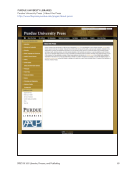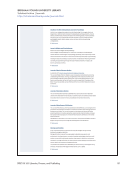60 Survey Results: Survey Questions and Responses
Illinois is very much still in a beta phase, so we are establishing publication guidelines, editorial
workflows, and other policies—we definitely have more policies than publications at the moment.
Michigan considers Michigan Publishing to be an entirely merged unit, a division of the library that is
equal to Research, Learning and Teaching, Operations, etc. in status. Michigan Publishing consists of
three front-facing brands—University of Michigan Press, Michigan Publishing Services, and Deep Blue
(the IR). Behind the scenes these share many functions, but they represent different levels of publishing
intervention to authors. Michigan Publishing was formed by merging the Scholarly Publishing Office
(SPO—a library publisher started in 2000) with University of Michigan Press (UMP—a university press
started in 1930) in 2009. It has been difficult to answer this survey meaningfully as a merged entity
because it assumes that “collaboration” is the closest one comes to a relationship between university
press and library publisher.
Our library decided not to become a press but focus more on providing the tools for editors and/or
authors to use the DC platform as the springboard for their publishing activities. This is due to our
current budget constraints and lack of Institutional support at this point. It is our hope to use the
creation of the publishing services program as a proof-of-concept to showcase how OA publishing can
be supported by the library but also to identify potential collaborators and/or funders in our institution
that can support this service.
Our press is brand new with books just starting to come into the pipeline. We are intentionally narrow in
our scope to allow proper time for scale. My answers in part are based on our expected publications in
the next 12 months.
Publishing activities are not quite developed at the library. We have a publishing support project that
is underway, which is a journal-hosting platform. The scholarly communications librarian hasn’t had
the time to develop a lot since the creation of the position, because his time was consumed by our
institutional repository project until a few months ago. We also make available in PDF format electronic
theses and dissertations. But this pretty much sums up what we’ve done so far.
Several years ago when I was hired, I searched and searched for anyone interested in electronic
publishing. A few student groups were. We briefly worked with them, but our publishing system (OJS)
was too complex for what they wanted to do. We have used OJS to publish two open access journals
in our School of Education. And we’ve used OCS to host one conference, with another one on the way.
We’ve had great success using Omeka as an online exhibitions platform, both for official libraries and
museums exhibitions as well as for use in the classroom. I think a small and successful library-based
publishing program can be created with open source tools, a modicum of server infrastructure, a
collegial librarian-technologist collaboration, and a hearty roll-up-your sleeves attitude!
Some of our respondents felt that digital preservation activities were under-represented in this survey.
The library invests heavily in this area as well.
The kind of publishing happening at our institution is not the same as what an officially established
press would take on. Our publishing is driven by our desire to support open access. It offers a means of
disseminating research that does not rely on established, for-profit presses. As a result, it is not managed
or operated as a formal press.
The two departments involved in publishing are working on different aspects of the
Libraries publishing.
The university press benefits from economies of scale through its integration with the library’s financial,
human resources, and technological support infrastructure.
Unfortunately, because we are still developing our publishing services (unrelated to ETDs/IR) we are
not able to provide answers to some of the questions. Nor do we feel qualified to offer lessons learned at
this time.
Illinois is very much still in a beta phase, so we are establishing publication guidelines, editorial
workflows, and other policies—we definitely have more policies than publications at the moment.
Michigan considers Michigan Publishing to be an entirely merged unit, a division of the library that is
equal to Research, Learning and Teaching, Operations, etc. in status. Michigan Publishing consists of
three front-facing brands—University of Michigan Press, Michigan Publishing Services, and Deep Blue
(the IR). Behind the scenes these share many functions, but they represent different levels of publishing
intervention to authors. Michigan Publishing was formed by merging the Scholarly Publishing Office
(SPO—a library publisher started in 2000) with University of Michigan Press (UMP—a university press
started in 1930) in 2009. It has been difficult to answer this survey meaningfully as a merged entity
because it assumes that “collaboration” is the closest one comes to a relationship between university
press and library publisher.
Our library decided not to become a press but focus more on providing the tools for editors and/or
authors to use the DC platform as the springboard for their publishing activities. This is due to our
current budget constraints and lack of Institutional support at this point. It is our hope to use the
creation of the publishing services program as a proof-of-concept to showcase how OA publishing can
be supported by the library but also to identify potential collaborators and/or funders in our institution
that can support this service.
Our press is brand new with books just starting to come into the pipeline. We are intentionally narrow in
our scope to allow proper time for scale. My answers in part are based on our expected publications in
the next 12 months.
Publishing activities are not quite developed at the library. We have a publishing support project that
is underway, which is a journal-hosting platform. The scholarly communications librarian hasn’t had
the time to develop a lot since the creation of the position, because his time was consumed by our
institutional repository project until a few months ago. We also make available in PDF format electronic
theses and dissertations. But this pretty much sums up what we’ve done so far.
Several years ago when I was hired, I searched and searched for anyone interested in electronic
publishing. A few student groups were. We briefly worked with them, but our publishing system (OJS)
was too complex for what they wanted to do. We have used OJS to publish two open access journals
in our School of Education. And we’ve used OCS to host one conference, with another one on the way.
We’ve had great success using Omeka as an online exhibitions platform, both for official libraries and
museums exhibitions as well as for use in the classroom. I think a small and successful library-based
publishing program can be created with open source tools, a modicum of server infrastructure, a
collegial librarian-technologist collaboration, and a hearty roll-up-your sleeves attitude!
Some of our respondents felt that digital preservation activities were under-represented in this survey.
The library invests heavily in this area as well.
The kind of publishing happening at our institution is not the same as what an officially established
press would take on. Our publishing is driven by our desire to support open access. It offers a means of
disseminating research that does not rely on established, for-profit presses. As a result, it is not managed
or operated as a formal press.
The two departments involved in publishing are working on different aspects of the
Libraries publishing.
The university press benefits from economies of scale through its integration with the library’s financial,
human resources, and technological support infrastructure.
Unfortunately, because we are still developing our publishing services (unrelated to ETDs/IR) we are
not able to provide answers to some of the questions. Nor do we feel qualified to offer lessons learned at
this time.



















































































































































































